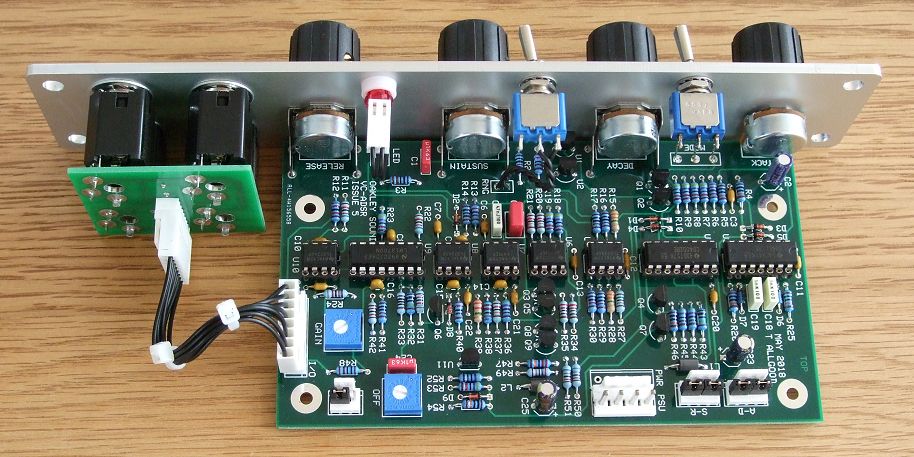
PCBs for this module are now discontinued

This is a very popular dual purpose module. Not only does it feature a looping four stage envelope generator, but it also has a high quality VCA onboard.
Two outputs are provided, one, labelled ADSR, is the raw output of the core ADSR generator. The other, VCA OUT, is the output of the integral VCA. This highly useful circuit implementation hardwires the ADSR generator to the control input of the VCA. The signal at the VCA's signal input, the VCA IN socket, will then be multiplied by the ADSR waveform. You can use any signal into this input, audio or CV. If you use CV, then the ADSR output level will be governed by the level of the CV. If you use audio, then the ADSR waveform will control the volume of that audio signal.
A typical use would have the IN socket being driven by the velocity CV from a midi-CV convertor. Thus the harder you hit the keys, the greater the ADSR output level. If you use this to control a filter sweep, this can create brilliantly effective touch sensitivity to your patch.
The circuit is configured so that if nothing is plugged into the IN socket, the VCA OUT will behave the same as the raw ADSR output.
The ADSR is operated by a gate signal, but can also be triggered by slow rising CVs too due to the built in schmitt trigger function. No additional 'trig' input is required.
The ADSR/VCA module is built on one PCB called the VC-ADSR board. Although the 1U panel design does not imply a voltage controlled design, the internal electronics are all voltage controllable. This allows blisteringly fast minimum attack and decay times. And yet, the controls with their true exponential response, allow you to accurately adjust faster times with ease.
Also on this module is an LED. This gives a visual indication of the output level of the internal ADSR waveform.
The module accommodates either our standard Oakley/MOTM power header or a Synthesizers.com power header. Current draw is around 35mA. The four layer printed circuit board (PCB) is 143 mm (high) x 81 mm (deep).
For DIY builders of this module it is possible to purchase the Sock4 circuit board which is available separately. The little Sock4 board speeds up the wiring of the four 1/4" sockets and reduces the chances of any wiring errors.
Loop Modes
The Oakley ADSR/VCA incorporates a looping mode. Looping means that the output will rise to the attack peak at the speed determined by the attack pot and then fall to 0.5V at the speed determined by the Decay pot. It will then rise again to the attack peak and then fall back to 0.5V and so on.
NORM - the module behaves as a standard ADSR.
GATED - the output will loop only when gate is high. As soon as gate arrives the output will rise up at the attack speed and then decay at the decay time and repeat. If the gate is removed at any point the output will then fall at the release time.
LOOP - The module's output will loop continuously in AD mode. The Gate input has no effect in Loop mode.
In both looping modes the position of the sustain pot can be used to turn the looping on or off. At values above 10% the looping will stop. This is very useful in the 2U version of the module where the looping can be controlled by an external CV.
Upgradable Design
This module can be upgraded to full voltage control with an addition of an extra module that uses the 'ADSR Upgrade' PCB. This board takes up a single width of panel space, and is fitted next to the ADSR/VCA module to be controlled. The upgrade can be added on at any time and installation is very simple. Two small interconnects behind the front panels allow the two boards to 'talk' to each other. See the VC-ADSR page for more details of the upgrade and the 2U VC-ADSR/VCA module.
Specifications:
Attack times: 0.2 milliseconds to 32 seconds (fast) or 1.6 ms to 250 seconds (slow). Charging voltage +10V, internal attack peak +5V. Pseudo linear ramp.
Decay/Release times: 0.38 ms to 50 s (fast) or 3 ms to 400 seconds (slow). Time measured from 90% of sustain value to 10% of sustain value. Exponential decay slope.
Sustain levels: 0 to 100%
The attack peak and maximum sustain level is 5V from the ADSR socket.
With no jack plug inserted into the IN socket, the attack peak and maximum sustain level is 5V from the VCA OUT socket.

The four layer issue 5 VC-ADSR PCB behind a natural finish Scheaffer panel and fitted with optional Sock4 board. Note also the two four way headers that can be attached to the optional 'ADSR Upgrade' module to allow for full voltage control over A, D, S and R parameters.
Project Downloads
Builder's Guide for the issue 5 PCB
Construction Guide Our handy guide to building Oakley DIY projects
Parts Guide Our handy guide to buying parts for Oakley DIY projects
Schematics are only available to purchasers of the PCB(s) and will only be sent via e-mail when the board(s) are shipped.
Builder's Guide for the older issue 3 & 4 PCBs
Front Panel database
A Schaeffer front panel can be made for this module. The databases can be found by downloading the following links:
5U format in traditional black
5U format (original symmetrical design) in traditional black
To read, edit and print these files you will need a copy of 'Frontplatten Designer' from Schaeffer. Panels can be ordered via the program using its secure online ordering system.
Schaeffer are based in Berlin, Germany and can send panels to anywhere in the world. Delivery to the UK normally takes around ten days. For North American users you can also order your Schaeffer panels from Front Panel Express.
Back Home: Oakley Sound